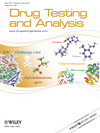
Drug Testing and Analysis
Scope & Guideline
Unveiling Insights in Pharmaceutical and Environmental Chemistry
Introduction
Aims and Scopes
- Analytical Method Development:
The journal emphasizes the development of new analytical methods, such as liquid chromatography-tandem mass spectrometry (LC-MS/MS), high-resolution mass spectrometry, and other advanced techniques to improve the detection of drugs and their metabolites in biological samples. - Doping Control and Sports Medicine:
A significant focus is placed on doping control in sports, including the detection of anabolic agents, performance-enhancing substances, and gene doping. The journal publishes research that aids in the implementation of anti-doping measures and enhances the integrity of sports. - Forensic Toxicology:
The journal covers the application of analytical methodologies in forensic toxicology, including the detection of drugs in various biological matrices, post-mortem analysis, and the investigation of drug-related fatalities. - Pharmacokinetics and Metabolism Studies:
Research on the pharmacokinetics and metabolic profiles of drugs, especially in the context of doping, is a core area. This encompasses studies on how substances are processed in the body and their implications for drug testing. - Emerging Substances and New Psychoactive Drugs (NPS):
The journal highlights the emergence of new psychoactive substances, their identification, analysis, and the challenges they present in drug testing and regulation. - Equine Drug Testing:
Special emphasis is placed on drug testing in equine sports, addressing unique challenges and methodologies specific to this area of research.
Trending and Emerging
- Biomarker Discovery and Validation:
Recent studies are increasingly focused on identifying and validating biomarkers for doping detection, particularly in equine and human samples. This trend is crucial for developing more reliable testing protocols and improving the accuracy of doping control. - Non-invasive Sampling Techniques:
There is a growing interest in non-invasive sampling methods, such as hair and dried blood spots, for drug testing. Research in this area aims to enhance the practicality and effectiveness of drug detection in various contexts, including sports and forensic investigations. - Multi-Method Analytical Approaches:
The trend towards using a combination of analytical techniques, such as LC-MS/MS alongside immunoassays or other methods, is on the rise. This approach aims to improve the reliability and comprehensiveness of drug testing results. - Focus on New Psychoactive Substances (NPS):
The journal is increasingly addressing the challenges posed by new psychoactive substances, reflecting a trend in drug testing that prioritizes the identification and analysis of these emerging compounds. - Artificial Intelligence and Machine Learning in Drug Testing:
There is an emerging theme of utilizing AI and machine learning techniques to enhance drug testing methodologies, data analysis, and interpretation of results, indicating a forward-looking approach to drug testing.
Declining or Waning
- Traditional Drug Testing Methods:
There seems to be a decline in papers focusing on traditional drug testing methods, as newer, more innovative techniques gain traction. This shift reflects the ongoing evolution of analytical technologies that enhance the sensitivity and specificity of drug detection. - General Pharmacology Studies:
Research that broadly covers pharmacological effects without a direct link to drug testing or doping control appears to be less frequent. The journal seems to prioritize studies directly applicable to doping detection and forensic applications. - Basic Toxicology Studies:
There is a noticeable decrease in basic toxicology studies that do not specifically address doping or drug testing contexts. The journal is increasingly focused on applied research that has immediate implications for sports and forensic settings.
Similar Journals
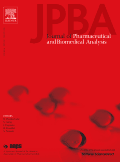
Journal of Pharmaceutical and Biomedical Analysis
Unraveling complexities in drug development and clinical biochemistry.The Journal of Pharmaceutical and Biomedical Analysis, published by ELSEVIER and available in print and online formats, stands as a pivotal source of knowledge in the realms of Analytical Chemistry, Clinical Biochemistry, Drug Discovery, and Pharmaceutical Science. With an ISSN of 0731-7085 and an e-ISSN of 1873-264X, this journal is dedicated to publishing high-quality research that advances the understanding and development of analytical techniques in pharmaceuticals and biomedicine. The journal has earned a solid reputation, reflected in its Q2 category rankings across five distinct fields for 2023, and boasts impressive Scopus rankings, signaling its robust impact within the academic community. The Journal of Pharmaceutical and Biomedical Analysis serves as an essential resource for researchers, professionals, and students alike, providing actionable insights and fostering innovation that can directly influence future advancements in drug development and biomedical applications.
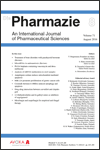
PHARMAZIE
Empowering innovation in pharmaceutical sciences.PHARMAZIE is a prestigious, peer-reviewed journal published by AVOXA-MEDIENGRUPPE DEUTSCHER APOTHEKER GMBH, focusing on the dynamic field of pharmaceutical science since its inception in 1947. With its ISSN 0031-7144 and a current impact factor placing it in the Q2 category of Pharmaceutical Science journals, PHARMAZIE has established itself as a pivotal resource for researchers, practitioners, and students alike. The journal emphasizes the dissemination of high-quality, original research in pharmacology, toxicology, and pharmaceutics, contributing to the advancement of knowledge and innovation in these fields. While currently not open access, the journal maintains a commendable Scopus rank of #94 out of 183 in its category, highlighting its relevance and appeal to the academic community. With a commitment to bridging the gap between research and practical applications, PHARMAZIE plays a crucial role in shaping the future of pharmaceutical practices and policies.

Brazilian Journal of Analytical Chemistry
Empowering Researchers Through Open Access KnowledgeBrazilian Journal of Analytical Chemistry, published by VISAO FOKKA COMMUNICATION AGENCY, serves as a vital platform for those engaged in the field of analytical chemistry, especially within the Latin American context. With an ISSN of 2179-3425 and an E-ISSN of 2179-3433, this journal aims to promote high-quality research and advancements in analytical methodologies, instrumentation, and applications spanning from 2010 to the present. Although it currently holds a Q4 rank in Analytical Chemistry by Scopus and is placed at the 24th percentile, its commitment to open access publishing provides invaluable opportunities for widespread dissemination of knowledge, catering to researchers, professionals, and students alike. The journal's editorial board comprises emerging and established experts aiming to bridge gaps in analytical chemistry research, particularly in a Brazilian and broader South American context. Situated in São Paulo, Brazil, the journal's role in fostering innovation and collaboration in analytical techniques makes it an essential resource for the academic community.

BMC Chemistry
Driving Scientific Advancement, One Article at a TimeBMC Chemistry, published by BMC, is a reputable open access journal that has made significant strides since its inception in 2019. Operating under e-ISSN 2661-801X, this journal is dedicated to advancing the field of general chemistry by promoting high-quality research across various sub-disciplines. Headquartered in the United Kingdom, BMC Chemistry boasts a commendable impact factor and is classified in Q2 within the prestigious field of Chemistry (miscellaneous) according to the 2023 category quartiles. The journal's Scopus ranking places it at #139 out of 408 in its category, highlighting its growing relevance and influence in the academic community, with a commendable 66th percentile standing. With a commitment to open access, BMC Chemistry ensures that groundbreaking discoveries and innovative research are available to a global audience, fostering collaboration and development in chemistry. Researchers, professionals, and students alike will find this journal to be an invaluable resource for disseminating knowledge and driving scientific advancement.

CHINESE JOURNAL OF ANALYTICAL CHEMISTRY
Unveiling New Horizons in Chemical AnalysisCHINESE JOURNAL OF ANALYTICAL CHEMISTRY, published by SCIENCE PRESS in China, stands as a prominent platform in the field of analytical chemistry since its inception in 1989. With its ISSN 0253-3820 and E-ISSN 1872-2040, the journal maintains a vital role in disseminating empirical research and innovative methodologies, contributing to the advancement of analytical techniques and their applications. The 2023 Scopus ranking positions the journal in the third quartile (Q3) within its category, reflecting a respectable standing among its peers. Researchers, professionals, and students alike engage with a broad range of topics, from instrumental analysis to environmental monitoring, each aiming to foster further scientific inquiry. Although it does not currently offer Open Access, the journal's rich repository of knowledge continues to be an essential resource for those in the analytical chemistry community, with an enduring commitment to scientific excellence and collaboration.

Chinese Journal of Chromatography
Empowering Researchers with Cutting-Edge Chromatographic TechniquesChinese Journal of Chromatography, published by SCIENCE PRESS, is a dedicated platform for disseminating pioneering research in the fields of Analytical Chemistry, Biochemistry, and Organic Chemistry. Established in 1997, this esteemed journal offers invaluable insights into chromatographic techniques and their applications, showcasing studies that contribute to the advancement of chemical engineering and electrochemistry. Although it currently holds a Q4 ranking in several categories, the journal aims to foster growth and knowledge among researchers, professionals, and students alike. With a continuous publication window extending until 2024, the Chinese Journal of Chromatography invites submissions that not only enhance scientific understanding but also address real-world challenges through innovative chromatographic solutions. Researchers looking for a collaborative community will find this journal a vital resource in their ongoing academic endeavors.
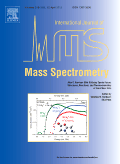
INTERNATIONAL JOURNAL OF MASS SPECTROMETRY
Elevating Understanding of Mass Spectrometry ApplicationsINTERNATIONAL JOURNAL OF MASS SPECTROMETRY, published by Elsevier, is a pivotal platform in the field of mass spectrometry, advancing the understanding and application of this essential analytical technique. With an ISSN of 1387-3806 and an E-ISSN of 1873-2798, the journal has established its significance since its inception in 1998 and continues to contribute valuable insights to the scientific community through its convergence of knowledge extending to 2024. Its scope encompasses critical areas such as condensed matter physics, instrumentation, physical and theoretical chemistry, and spectroscopy, earning recognition across various ranks and quartiles, specifically holding a Q3 classification in multiple categories for 2023. Although it does not currently operate under an open access model, the journal remains an essential resource for researchers, professionals, and students striving to deepen their expertise and stay abreast of the latest methodological developments and discoveries in mass spectrometry. With its commitment to quality and innovation, the INTERNATIONAL JOURNAL OF MASS SPECTROMETRY plays a crucial role in supporting advancements in analytical chemistry and instrumental analysis.
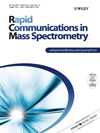
RAPID COMMUNICATIONS IN MASS SPECTROMETRY
Advancing the frontiers of mass spectrometry research.RAPID COMMUNICATIONS IN MASS SPECTROMETRY is a leading journal published by Wiley, focusing on the rapidly evolving field of mass spectrometry and its applications across various domains, including analytical, organic, and spectroscopy chemistry. With its ISSN 0951-4198 and an E-ISSN of 1097-0231, the journal has firmly established itself as a reputable source of innovative research since its inception in 1987, and is set to continue until 2024. As evidenced by its 2023 Scopus rankings, the journal occupies a solid position in the realms of analytical chemistry (Q3), organic chemistry (Q3), and spectroscopy (Q3), reflecting its impact among a diverse audience of researchers and professionals. Although it is not an open-access publication, the findings shared within its pages are pivotal for advancing knowledge and practical applications in mass spectrometry, making it an essential resource for students and experts aiming to stay abreast of the latest scientific developments.

Food Analytical Methods
Empowering researchers to enhance food safety standards.Food Analytical Methods, published by Springer, is an esteemed journal dedicated to the innovative field of analytical methodologies within the food sciences. With an ISSN of 1936-9751 and E-ISSN of 1936-976X, this journal serves as a pivotal platform for researchers and professionals to exchange insights, methodologies, and findings related to food quality analysis, safety measures, and innovative technologies in food science. As of 2023, Food Analytical Methods boasts impressive Scopus rankings, including Q2 in Analytical Chemistry and Food Science, positioning it among the top journals in its category. The journal's commitment to enhancing food safety and quality through rigorous research underscores its importance in both academic and industrial applications. Although it does not currently operate under an open-access model, it provides exceptional value through its rigorous peer-review process and comprehensive publication standards, further inviting contributions from both established and emerging scientists in the field. With coverage spanning from 2008 to 2024, this journal continues to address critical research areas, thereby shaping the future of food analytics.

ANALYTICAL AND BIOANALYTICAL CHEMISTRY
Driving Excellence in Bioanalytical MethodologiesANALYTICAL AND BIOANALYTICAL CHEMISTRY, published by SPRINGER HEIDELBERG, is a leading international journal that serves as a vital platform for innovative research in the fields of analytical and bioanalytical chemistry. With an impressive impact factor and ranking in the Q2 category for both Analytical Chemistry and Biochemistry, the journal highlights key advancements and methodologies that drive the discipline forward. Established in 1996 and continuing vigorously into 2024, it has gained significant recognition with Scopus rankings placing it in the 83rd and 78th percentiles within its categories, underscoring its impact and relevance. The journal's commitment to open access facilitates widespread dissemination of critical scientific knowledge, making it an essential resource for researchers, professionals, and students dedicated to exploring the complexities of chemical analysis. With its base in Heidelberg, Germany, ANALYTICAL AND BIOANALYTICAL CHEMISTRY continues to inspire and influence the global research community.